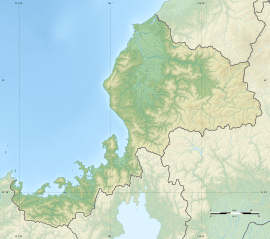Nishizuka Kofun
Nishizuka Kofun (西塚古墳, Nishizuka Kofun) is a keyhole-shaped kofun burial mound located in what is now part of the town of Wakasa, Fukui in the Hokuriku region of Japan. The site was designated a National Historic Site of Japan in 1935.[1]
西塚古墳 | |
%2C_kouenbu-2.jpg) Nishizuka Kofun | |
 Nishizuka Kofun  Nishizuka Kofun (Japan) | |
| Location | Wakasa, Fukui, Japan |
|---|---|
| Region | Hokuriku region |
| Coordinates | 35°28′5.94″N 135°52′23.76″E |
| Type | kofun |
| History | |
| Founded | 5th century AD |
| Periods | Kofun |
| Site notes | |
| Ownership | National Historic Site |
| Public access | Yes |
Overview
The Nishizuka Kofun is one of a group of seven kofun located in the Wakibukuro neighborhood of central Wakasa, west of the tracks of the JR West Obama Line railway and to the west of the Jōnozuka Kofun. Together with the Jōnozuka Kofun and the Nakatsuka Kofun, it was known to local legend as the tomb of one of the "Kings of Wakasa". The entire length is about 74 meters, with the circular portion having a diameter of 39 meters, and the width of the square portion at 47 meters. However, most of the square portion of the structure was destroyed during the construction of the Obama Line railroad in August 1916, and the round tumulus lies isolated in the middle of a rice field. The round tumulus has a height of 6.7 meters and was covered in fukiishi. Fragments of haniwa have been found in the surrounding fields. The tumulus was also originally surrounded by a 20-meter wide moat.
During the railroad construction, the 5.46 x 1.3 meter stone burial chamber was discovered and numerous burial goods were excavated. The burial chamber had a height of 1.5 meters and was painted red with cinnabar. Bronze mirrors, possibly of Chinese origin, magatama and cylindrical beads, gold earrings, metal belt fittings, horse ornaments, and weapons including swords, spears and fragments of amor were found, all of which are currently in the possession of the Museum of the Imperial Collections in Tokyo. Judging from these artefacts, the tomb was constructed in the late 5th century AD (the middle Kofun period), and mostly likely corresponds to the grave of one of the Kuni no miyatsuko of Wakasa Province.
The site was subsequently excavated in 1970 and in 1991, and in 2008 by ground-penetrating radar.
References
- "西塚古墳" [Nishzuka kofun] (in Japanese). Agency for Cultural Affairs.
External links
- Obama city home page (in Japanese)
- Fukui Prefectural home page (in Japanese)